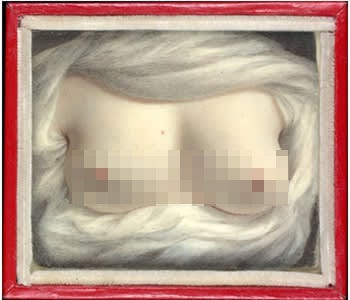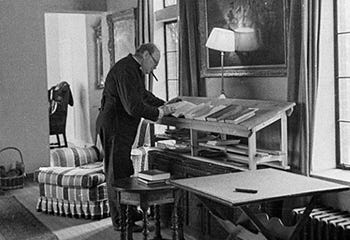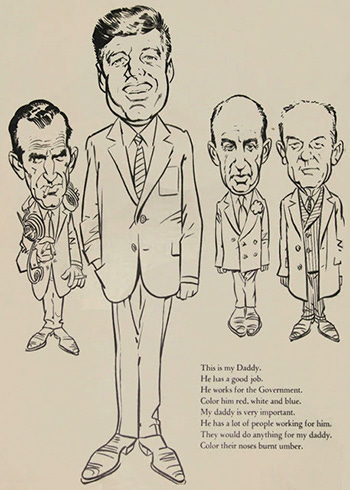6 Millennial Fads That Are Way Older Than You Think
Guess what? Half of the Millennial trends your grandpa complains about are actually even older than he is.

There are a few things almost everyone agrees on: Water is wet, babies are cute, and Millennials are the worst generation humanity has ever created. There isn't a thing they like, from selfies to avocado toast, that hasn't become a sign that their inventions and fads are ruining the very fabric of society. But guess what? Half of the "Millennial" trends your grandpa complains about are actually even older than he is. For example ...
6. "Sexting" Has Been Around Since The Renaissance
It's unsurprising that the invention of a device that is capable of both taking pictures and sending those pictures to another human being was followed immediately by the invention of the practice of sending people photos of your own sex bits -- or as people much cooler than we are call it, "sexting." But the idea of "sending nudes" in order to make someone horny for you is much older than camera phones. Hell, it's older than cameras.
Take this 17th-century portrait of a lady preparing food while a black servant gives her an expression that seems to ask "Why are your boobs out?" The woman in the picture is Nell Gwyn, comedic actress and mistress to English King Charles II, who sent this lusty portrait to her lover sometime during their 16-year affair. The very suggestive piece shows a virginal white Gwyn flash ample cleavage while "stuffing sausages," which we'll assume was the Renaissance equivalent of sending the eggplant emoji. The original picture, made by a wisely anonymous painter in the late 17th century, is only a little larger than a postcard -- not big enough to hang on a wall, but probably just about the right size to carry around in a king-sized pocket and show to his ducal bros.
Flash-forward to 1828, and this self-portrait by Boston painter Sarah Goodridge might be the first sext selfie. And unlike Gwyn, Goodridge knew there was a quicker way into a man's unmentionables than some subtle iconography:
She sent this as a gift to none other than U.S. senator Daniel Webster. It's a miniature painting, measuring around 2x3 inches, which was popular at the time. Pretty useless for display, but handy for, say, keeping it hidden from your wife. Webster and Goodridge insisted they were only close friends, and historians have found no evidence they were doing the wild thing. Except, of course, for exhibit Double D.
Naturally, when cameras came along, sexting became a lot easier. The media already knew about the trend as early as 1860, warning ladies against the improper behavior of "giving daguerreotypes of themselves to young men who are merely acquaintances."
And during the early 1900s, it was common for women to send racy pictures of themselves to their husbands on the battlefield to show them what was waiting at home (a very blurry half-dressed woman). There are plenty of attics everywhere that might contain such saucy pictures in a dusty box, claims English Professor Joshua Adair -- a fact that he likes to illustrate to his horrified students by showing them a photo he found of his pantsless grandmother.
5. People Were Using Selfie Sticks In The 1920s
Selfies might be the worst thing Millennials have embraced with outstretched arms, apart from Nazism. But until recently, selfies had been an awkward thing to pull off, holding the camera as far away as possible while as your trembling hand tries to frame all of your friends' duckfaces. In came the selfie stick, still the most divisive popular invention of our time. Some people love them, other people love that they cause users to sometimes walk onto train tracks. But for all the crap oldies give kids about their selfie sticks, they've been around for almost a century.
Of course, selfies themselves started around five minutes after the camera was invented. But surely, selfie sticks had to wait until cameras got tiny or people's biceps got massive, right? That's why the selfie stick only officially dates back to around 2005. But when BBC News mentioned this in a column recently, it prompted one reader, Alan Cleaver, to send them this photo of his grandparents from 1925:
The dashing gentleman in the pictograph is Arnold Hogg, simultaneously using the earliest known selfie stick and conveniently providing photographic evidence of it. Unfortunately, the context of this image has been lost to time, but if you look at the picture, it's quite obvious that that's the face of a guy who just invented the selfie stick, while the expression on his wife's face is definitely that of a woman who just realized she married the inventor of the selfie stick.
4. Text Speak Dates Back To The Telegraph Era
We're always hearing about how SMS, Twitter, and other quick messaging platforms are destroying the English language by converting it into a bunch of shorthand gibberish. Not like in the old days, naturally, when people wrote out all of their correspondence in full with a quill pen. But now, with their abbreviations and emoticons, Millennials are all hammering out 140-character screeds that look like a shitty Rosetta Stone translating bad English to Pac-Man hieroglyphs.
And that's probably the same complaint that people had when everyone started doing it back in the 1870s.
Back before the telephone, there was the telegraph, which you might liken to an early form of SMS. You'd write a short message and pay your local operator to tap it out in Morse code to your chosen recipient. But telegraphy was expensive, and it charged by the letter, meaning eloquence could easily cost you an entire week's salary in the nickel mines. As a penny-pinching response, people derived a shorthand language that looks remarkably similar to the kind of text speak that Baby Boomers complain about today, as you can see from this 1901 textbook:
In fact, a lot of accursed Millennial speak can be traced directly to the abbreviations used by fast-tapping telegraphers. Most notably, the letter "U" for "you" or "R" for "are." Telegraphers also used "ty" for "thank you" and "pls" for "please." And though they didn't say "LOL," they would indicate laughter with "HI HI" (which required fewer dots than either HA HA or HE HE).
Maybe the most surprising acronym to come out of this era is "OMG," which has been traced as far back as a letter from Admiral John Fisher to Winston Churchill in 1917:
3. A Whole Bunch Of Historical Figures Used Stand-Up Desks
If you work in an office, you might have heard that sitting is the new smoking. (Also, leaning is the new doing meth. Tell your friends.) So in order to combat the tyranny of comfort, the hip new trend in offices everywhere is the standing desk, used frequently by Millennial workers who buy into the often-disputed health claims, thinking they're better than older generations who sat down their entire lives and didn't act like precious snowflakes about it. Well guess what, bitter old man we made up: You've now called our Founding Fathers snowflakes. Traitor.
Turns out that a whole host of historical figures found it preferable to do their desk work on their feet. It's purported that Leonardo da Vinci liked to draft his anachronistic contraptions standing up. In more recent times, we have firsthand accounts from lots of writers and politicians who liked it better that way, including Benjamin Franklin and Thomas Jefferson.
The biographers of Lewis Carroll, Nathaniel Hawthorne, and Virginia Woolf all also claimed that their respective subjects cranked out their books on their feet. In 1888, philosopher Friedrich Nietzsche even snapped at the novelist Gustave Flaubert, who claimed, "One cannot think and write except when seated," by saying, "The sedentary life is the very sin against the Holy Spirit. Only thoughts reached by walking have value." Which is kind of the 19th-century version of what an obnoxious Millennial would say to their manager while slurping on a pumpkin spice Frappuccino.
Of course, before standing desks were popular enough to be mass-produced, most people were forced to jury-rig them. Here's a photo of Winston Churchill working at a desk that looks to have been propped up on some kind of cabinet:
Ernest Hemingway also improvised his own standing desk by putting his typewriter on top of a bookcase, claiming, "Writing and travel broaden your ass if not your mind and I like to write standing up."
Then there's this photo of 30-year-old Marvel Comics co-founder Stan Lee (yes, he was young once), who made a standing desk out of a bench on top of a table so that he could write not only standing up, but also outside and shirtless. As he claimed: "Always wrote standing up -- good for the figure -- and always faced the sun -- good for the suntan!"
2. Adult Coloring Books Date Back To The 1960s
In 2015, the publishing industry saw a considerable spike in profits when coloring books for adults became the hottest new trend, even if they're already on the way out again. Of course, there's no considerable difference in execution between coloring books made for kids and those made for adults, except one is to to get whiny brats to shut up, while the other is for kids. (Ha! Take that, Millennials!)
Except that adult coloring books were also a fad for another generation: the Greatest Generation. Coloring books have been published for adults since the early '60s, and they carried the same cynical tone toward our stressful day-to-day existence. 1961's The Executive Coloring Book featured images of a man going through his daily routine, with satirical captions like "This is my desk. It is mahogany. I wish I were mahogany" and "This is my suit. Color it gray or I will lose my job."

In 1962, the JFK Coloring Book became the first coloring book to hit the New York Times bestseller list, where it stayed there for 14 whole weeks. It contained 22 pages of mockery aimed at the Kennedy administration, with instructions to paint Kennedy "red, white and blue," and to color the noses of his staff "burnt umber." It's nice to see that conservative humor hasn't lost any of its staleness today.
The John Birch Society Coloring Book made fun of a prominent '60s conspiracy theory group (kind of the Infowars of the Cold War):
Jokingly, it even contained one totally blank page, with the caption "How many Communists can you find in this picture? I can find 11. It takes practice."
1. Women Were Getting Sleeve Tattoos And Nipple Piercings In The Victorian Age
Have you ever heard someone make that overused joke about how ridiculous hipsters with sleeve tattoos are going to look 40 years from now? Goodness, we'll have entire retirement homes filled with saggy bodies look like Salvador Dali's droopy phase! Not like in the past, when a tattoo was nothing but a tasteful picture of an anchor on your Navy granddad's bicep, or a cheeky little butterfly on your hippie grandma's left ankle.
Well surprise! There's nothing new about chicks getting inked up. In fact, the trend dates back at least to the mid-1800s. Like anyone getting a buttload of tattoos, their reasoning also had to do with rebelling against societal norms and regimented gender roles, with the added bonus of looking cool as hell. Many notable aristocratic women in the Victorian era were known to have tattoos, including (rumor has it) Winston Churchill's mom.
But it was, of course, the lower classes that got the most out of being as anti-establishment as possible. Many of the poor and downtrodden, the people you never read about in your textbooks, inked themselves up as elaborately as the patrons of your average modern craft beer festival.
Those two hipster assholes are Nora Hildebrandt and Maud Wagner, a couple of circus performers from the late 1800s who became well-known for their elaborate body art. But the controversy around these colorful women didn't end at their tats. They caused quite a scandal when, in order to display every inch of their art, they would lift up their petticoats to show them. Leave it to the Victorian Era to be more disturbed by a bare thigh than a full-body tattoo.
But are tattoos really the most shocking thing 19th-century ladies could stab onto their bodies? Not even close. That honor goes to the Victorian nipple rings. While historians find it difficult to properly research things like Victorian peachrangs due to the intimacy and secrecy involved, some European medical journals have been uncovered that reference their female patients' nipple jewelry as far back as 1857. Sometimes they were even connected by chains, because your great-great-grandma was much more hardcore than you will ever be. Some women thought that the procedure allowed them to develop bigger, rounder, firmer breasts due to the "constant excitation of the nerves caused by the rings." And if you were a woman in the 1800s, excitation of the nerves was in short supply.
So what about the dudes? Surely, Victorian men wouldn't dream of getting something as metal as a dick piercings? Well, not only did they consider them fashionable, but even a sign of modesty. You see, another fashion fad of the mid-19th century was incredibly tight-fitting pants -- so tight that they left very little to the imagination. To better tuck their little sinners away from God-fearing eyes, well-off men would anchor their enormous Pride And Prejudice penises with a rod of metal (later called a "Prince Albert") inside their pants to not fluster any godly women. So if you're ever feeling insecure, take a moment to remember that your great-granddad probably had to use a barbell to secure his titanic manhood under his trousers. You won't thank us later.


























